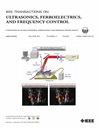Piezoelectric Microacoustic Metamaterial Filters
IF 3
2区 工程技术
Q1 ACOUSTICS
IEEE transactions on ultrasonics, ferroelectrics, and frequency control
Pub Date : 2024-07-24
DOI:10.1109/TUFFC.2024.3432849
引用次数: 0
Abstract
We present the first microacoustic metamaterial filters (MMFs). The bandpass of the reported MMFs is not generated by coupling, electrically or mechanically, various acoustic resonances; instead, it originates from the passbands and stopbands of a chain of three acoustic metamaterial (AM) structures. These structures form an AM transmission line (AMTL) and two AM reflectors (AMRs), respectively. Two single metal strips serve as input and output transducers with a wideband frequency response. Since MMFs do not rely on resonators, they do not require high-resolution trimming or mass-loading steps to accurately tune the resonance frequency difference between various microacoustic resonant devices. These steps often involve finely controlling the thickness of a device layer, with resolutions that can be as low as a few Angstroms when building GHz filters. The acoustic bandwidth of MMFs is mostly determined by geometrical and mechanical parameters of their AM structures. MMFs necessitate external circuit components for impedance matching, in contrast to the existing microacoustic filters that often employ circuit components only to eliminate ripples within their passband. We have designed and constructed the first MMFs from a 400-nm-thick scandium-doped aluminum nitride (AlScN) film using a 30% scandium-doping concentration. These devices operate in the radio frequency (RF) range. We validated these devices’ performance through finite-element modeling (FEM) simulations and through measurements of a set of fabricated devices. When matched with ideal circuit components, the built MMFs exhibit filter responses with a center frequency in the ultrahigh-frequency range, a fractional bandwidth (FBW) of ~2.54%, a loss of ~4.9 dB, an in-band group delay between压电微声超材料滤波器。
我们提出了首个微声超材料滤波器(MMF)。报告中的 MMF 的带通不是通过电子或机械耦合各种声共振产生的,而是源自三个声超材料(AM)结构链的通带和止带。这些结构分别构成一条调幅传输线(AMTL)和两个调幅反射器(AMR)。两个单金属带作为输入和输出换能器,具有宽带频率响应。由于 MMF 不依赖于谐振器,因此不需要高分辨率的微调或质量加载步骤,就能精确调节各种微声谐振装置之间的谐振频率差。这些步骤通常涉及精细控制器件层的厚度,在制造 GHz 滤波器时,分辨率可低至几个埃。MMF 的声学带宽主要由其 AM 结构的几何和机械参数决定。MMF 需要外部电路元件来实现阻抗匹配,而现有的微声滤波器通常只采用电路元件来消除通带内的纹波。我们利用掺杂 30% 钪的 400 纳米厚 AlScN 薄膜设计并制造出了首款 MMF。这些器件在射频 (RF) 范围内工作。我们通过有限元建模(FEM)模拟和对一组制造器件的测量验证了这些器件的性能。当与理想电路元件匹配时,所制造的 MMF 显示出滤波器响应,其中心频率在超高频范围内,分数带宽 (FBW) 约为 2.54%,损耗约为 4.9 dB,带内群集延迟在 70 ± 25 ns 之间,频率温度系数 (TCF) 约为 22.2 ppm/°C。
本文章由计算机程序翻译,如有差异,请以英文原文为准。
求助全文
约1分钟内获得全文
求助全文
来源期刊
CiteScore
7.70
自引率
16.70%
发文量
583
审稿时长
4.5 months
期刊介绍:
IEEE Transactions on Ultrasonics, Ferroelectrics and Frequency Control includes the theory, technology, materials, and applications relating to: (1) the generation, transmission, and detection of ultrasonic waves and related phenomena; (2) medical ultrasound, including hyperthermia, bioeffects, tissue characterization and imaging; (3) ferroelectric, piezoelectric, and piezomagnetic materials, including crystals, polycrystalline solids, films, polymers, and composites; (4) frequency control, timing and time distribution, including crystal oscillators and other means of classical frequency control, and atomic, molecular and laser frequency control standards. Areas of interest range from fundamental studies to the design and/or applications of devices and systems.

 求助内容:
求助内容: 应助结果提醒方式:
应助结果提醒方式:


